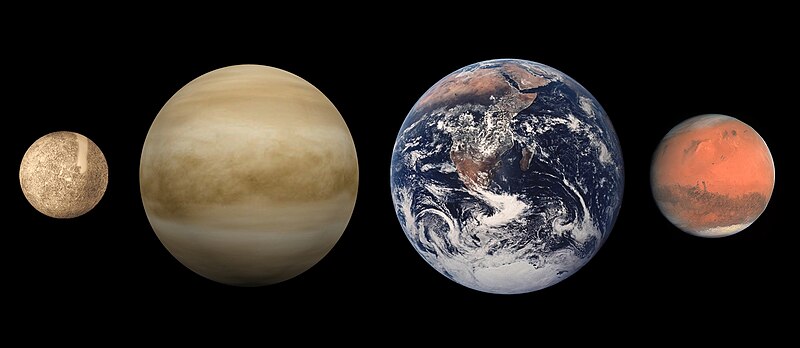Figura:Terrestrial planet size comparisons.jpg
Aspetto

Amzure dë sta preuva: 800 × 348 pontin. Àutre arzolussion: 320 × 139 pontin | 640 × 279 pontin | 1 500 × 653 pontin.
Archivi original (1 500 × 653 pontin, amzure: 314 KByte, sòrt MIME: image/jpeg)
Stòria dl'archivi
Ch'a-i daga un colp col rat ant sna cobia data/ora për ës-ciairé coma a restèissa l'archivi ant col moment-là.
| Data e Ora | Miniadura | Amzure | Utent | Coment | |
|---|---|---|---|---|---|
| dël dì d'ancheuj | 21:39, 4 Dze 2018 |  | 1 500 × 653 (314 KByte) | Allice Hunter | Correcting Mars |
| 18:21, 3 Dze 2018 |  | 1 500 × 653 (315 KByte) | Allice Hunter | updated: correcting the color of Mars. Based on image of Mars >> File:OSIRIS Mars true color.jpg. There was no distortion in size | |
| 23:37, 15 Luj 2012 |  | 1 500 × 653 (276 KByte) | Ubiquinoid | updated: correcting for apparent undersizing of Venus (from 90 to 95% (true) of Earth's diameter) - based on image of Venus w/NASA cloup map (resized) at http://cronodon.com/PlanetTech/Venus.html; centred | |
| 15:52, 15 Luj 2012 |  | 1 500 × 653 (79 KByte) | Ubiquinoid | updated: correcting for apparent undersizing of Venus (95% of Earth's diameter) - based on image of Venus w/cloup map (resized) at http://cronodon.com/PlanetTech/Venus.html | |
| 00:50, 28 Dze 2007 |  | 1 500 × 653 (456 KByte) | Crotalus horridus~commonswiki | Created identical and more compact version using the "Huffman optimized" feature of jpegcrop. Nothing else has been changed. | |
| 00:27, 15 giu 2006 |  | 1 500 × 653 (488 KByte) | Nicke L | {{Information| |Description= The inner planets, from left to right: en:Mercury, en:Venus, en:Earth, and en:Mars Source: http://solarsystem.nasa.gov/multimedia/gallery/terr_sizes.jpg |Source= |Date= |Author=User [[:en:User:Brian0918|Br |
Anliure a le figure
A-i é pa gnun-a pàgina che a dòvra sto archivi.
Dovragi global dël file
J'àutre wiki sì sota a deuvro st'archivi-sì:
- Usagi dzora af.wikipedia.org
- Usagi dzora arz.wikipedia.org
- Usagi dzora az.wikipedia.org
- Usagi dzora bat-smg.wikipedia.org
- Usagi dzora ba.wikipedia.org
- Usagi dzora be-tarask.wikipedia.org
- Usagi dzora beta.wikiversity.org
- Usagi dzora be.wikipedia.org
- Usagi dzora bxr.wikipedia.org
- Usagi dzora ca.wikipedia.org
- Usagi dzora cv.wikipedia.org
- Usagi dzora da.wikipedia.org
- Usagi dzora da.wikisource.org
- Usagi dzora de.wikipedia.org
- Usagi dzora de.wikisource.org
- Usagi dzora de.wikiversity.org
- Usagi dzora en.wikipedia.org
- User:Can't sleep, clown will eat me
- User:Newone
- Wikipedia:Featured picture candidates/Terrestrial planet size comparisons
- Wikipedia:Featured picture candidates/May-2006
- Talk:Dwarf planet/Archive 1
- Wikipedia:Featured picture candidates/February-2007
- Wikipedia:Featured picture candidates/Terrestrial planets
- User:Can't sleep, clown will eat me/User/appetizers
- Wikipedia:Featured picture candidates/August-2007
- Wikipedia:Featured picture candidates/Terrestrial planet size comparisons.jpg
- User:Mitternacht90/EarthandSpace
- User:HarryAlffa/Solar System synopsis
- Talk:Solar System/Archive 5
- User:Physchim62/Planetmass
Varda l'usagi global dë st'archivi-sì.


